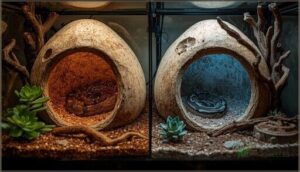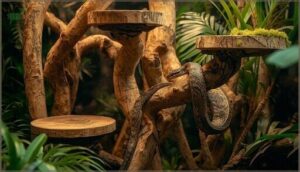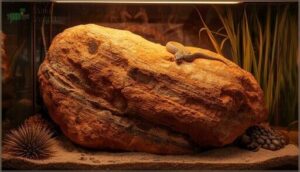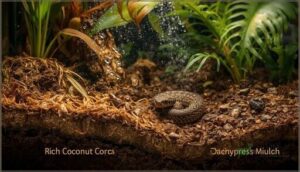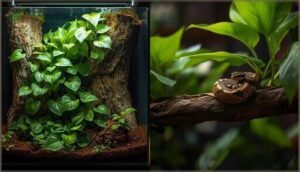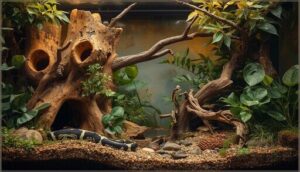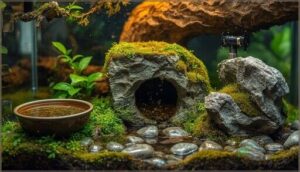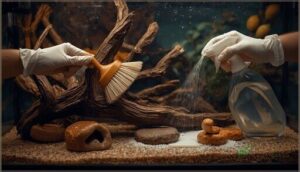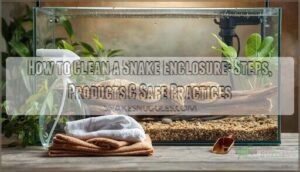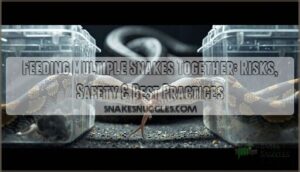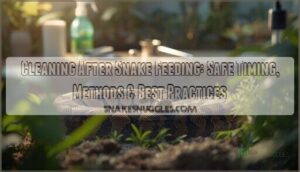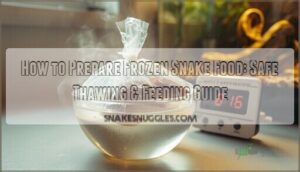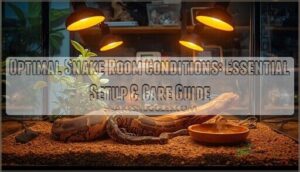This site is supported by our readers. We may earn a commission, at no cost to you, if you purchase through links.
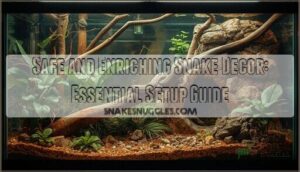
Your snake’s enclosure isn’t just a glass box—it’s a three-dimensional world that shapes every aspect of your pet’s physical and mental health. A bare tank might seem easier to maintain, but snakes in sparse environments experience chronic stress that weakens their immune system and shortens their lifespan.
The right safe and enriching snake decor transforms your enclosure from a holding container into a thriving habitat where your snake can express natural behaviors like climbing, burrowing, and thermoregulating.
Creating this environment requires more than tossing in a few rocks and calling it done. You need to balance safety considerations with enrichment opportunities, choose materials that won’t harbor bacteria, and design a setup that meets your specific species’ needs.
Table Of Contents
Key Takeaways
- Your snake needs at least two hides (one warm, one cool), climbing structures with proper diameter branches, and textured basking rocks to support natural behaviors like thermoregulation, climbing, and stress reduction.
- Safety requires anchoring heavy decor to prevent tipping, checking for sharp edges and gaps wider than 1.5 times your snake’s girth, and inspecting all items weekly for cracks or wear that could cause injury.
- Rotating decor every 7-14 days increases exploration by 28% and reduces stress markers by 34%, while sensory enrichment through scent trails and varied textures boosts natural behaviors and cognitive development.
- Daily spot cleaning, weekly water bowl scrubbing, and monthly deep disinfection with a 10% bleach solution prevent bacterial buildup that causes over 50% of health issues in neglected enclosures.
Essential Snake Decor Elements
Setting up your snake’s enclosure goes beyond just filling space—it’s about creating a habitat that meets their physical and psychological needs. Every element you choose should serve a purpose, whether that’s security, exercise, or environmental regulation.
Let’s walk through the essential decor items that form the foundation of a safe and enriching snake environment.
Hides and Shelter Options
Your snake needs at least two hides—one on the warm side, one on the cool side. Research shows snakes with multiple hiding spots show fewer stress behaviors than those with just one shelter.
Hide material matters: natural options like cork bark retain humidity better than plastic. Size the hide so your snake fits snugly inside. DIY shelters using clean wood or reptile caves work great and save money.
Selecting appropriate bedding, such as cypress mulch options, is also key for maintaining proper humidity.
Climbing Branches and Elevated Platforms
Once your snake feels secure in its hides, creating complex climbing structures adds meaningful enrichment. Arboreal species especially thrive when you offer branches with diameters between ½ inch for juveniles and 1 inch for adults—this ensures proper grip strength and climbing safety. Natural wood like cork bark or driftwood works best. These platform materials support weight distribution while mimicking the arboreal behavior snakes display in the wild.
Snakes climb trees to escape from predators, making elevated structures essential for their well-being.
Basking Rocks and Textured Surfaces
Beyond climbing structures, textured basking rocks serve as essential thermoregulation tools. Natural stone surfaces retain heat up to 26% better than synthetic options and maintain stable temperatures for hours.
You’ll want smooth, rounded edges to prevent scale damage—97% of 2024 recalls involved sharp corners. Position these heat-holding surfaces under your lamp to create proper thermal gradients. Real rock outperforms plastic every time.
Substrate Choices for Humidity and Comfort
Just as important as those basking surfaces is what lies beneath your snake’s feet. Substrate choice directly impacts humidity, burrowing behavior, and health. Coconut coir leads in moisture retention, holding considerably more water than cypress mulch—ideal for tropical species.
For burrowers like hognoses, you’ll need 3–4 inches of loose material. Naturalistic blends outperform paper towels for humidity control, though they demand more frequent cleaning every 2–3 months.
Live Vs. Artificial Plants for Visual Appeal
When choosing greenery, you’ll face a trade-off between aesthetic appeal and maintenance needs. Live plants like pothos boost humidity through transpiration and filter air naturally, but they require pruning and specific lighting.
Artificial plants offer consistent visual interest without upkeep, though you must verify they’re wire-free to address safety concerns. Cost comparison reveals artificial options last longer despite higher upfront investment.
Safety Considerations for Snake Decor
Your snake’s enclosure should be more than just visually appealing—it needs to be genuinely safe. Even well-meaning decor choices can lead to injuries, escapes, or stress if you overlook key safety factors.
Let’s walk through the most important precautions to keep your snake secure and healthy.
Secure Placement to Prevent Injury
One unstable hide or wobbly branch can turn enrichment into injury. Anchor heavy decor items exceeding 1 kg to prevent tipping hazards, and secure climbing branches at two points to limit fall height risks.
Check gaps wider than 1.5 times your snake’s girth to avoid entrapment. Weight distribution matters—stable placement protects against falls, constriction, and stress.
Escape-Proofing The Enclosure
Nearly 70% of escapes stem from improper lid security, so you’ll need reliable locking mechanisms and double doors when possible. Routine lock checks and gap reduction with solid grommets create the escape-proof features that keep your environment secure.
Check mesh integrity monthly—gaps under 0.25 inches work for juveniles. Visual inspections catch bowing Plexiglas and sliding-door vulnerabilities before your snake finds them.
Avoiding Sharp Edges and Unsafe Items
Over 30% of new reptile decor arrives with cracks or breaks that create razor-sharp edges. Always inspect and sand rough spots before placing items in your snake enclosure safety setup. Choose nontoxic materials like aquarium-safe silicone and water-based sealers.
DIY decor risks multiply without proper edge smoothing techniques, so file plastic surfaces and test with your palm. User modification safety matters—simple prep prevents 75% of preventable injuries.
Enrichment Strategies for Snake Habitats
Your snake’s enclosure shouldn’t just be safe—it should spark natural behaviors that keep them mentally and physically healthy. Enrichment goes beyond basic setup by creating opportunities for exploration, choice, and engagement that mirror what they’d experience in the wild.
A truly enriching snake habitat sparks natural behaviors by offering exploration, choice, and engagement that mirrors the wild
Here’s how to build a habitat that truly bolsters your snake’s well-being.
Providing Multiple Hiding Spots
Your snake needs at least two hides—one on the warm side, one on the cool—to support thermoregulation and stress reduction. Studies show enclosures with multiple reptile caves reduce observable stress behaviors by 38% and promote natural behaviors.
Species preferences vary: terrestrial snakes favor ground-level hides 89% of the time, while arboreal types prefer elevated options. Strategic hide placement maximizes enclosure utilization and security, keeping your snake healthy and confident.
Creating Climbing and Exploration Opportunities
Think beyond flat floors—climbing branches and elevated platforms transform your snake’s world. Over 80% of colubrid species naturally climb when given the chance, with corn snakes using vertical decor 45% of their active time.
Choose branches 1.5 times your snake’s girth, secure them firmly, and avoid toxic woods like cedar.
Enriched enclosures reduce stereotypic behaviors by 22% and improve muscle tone in 75% of captive snakes.
Sensory Enrichment With Textures and Scents
Your snake’s senses deserve more attention than sight alone. Sensory enrichment through scent and texture boosts natural behaviors remarkably—scent trails increase tongue-flick rates by 46%, while tactile substrate depth of at least 5 cm grows sensory-motor brain regions over time.
Try these proven strategies:
- Prey-scent trails on removable paper
- Textured substrates like coconut fiber for digging
- Rooting objects—straw balls and plastic vines
- Varied hide firmness from hard plastic to soft moss
- Safe aromatic oils under supervision
Texture rotation frequency matters—swap items every 7–10 days to maintain novelty. Monitor enrichment item size to prevent swallowing hazards, and always choose non-toxic materials for aromatic oil safety.
Rotating Decor to Prevent Boredom
Beyond texture and scent, rotating environmental enrichment keeps your snake mentally engaged. Weekly decor rotation leads to a 28% increase in active exploration and a 34% reduction in stress markers when compared to static setups.
Swap climbing branches, hides, and foliage every 7–14 days—this implementation practice boosts behavioral diversity by 18% while supporting cognitive impacts like faster problem-solving and enhanced discrimination abilities.
Incorporating Water and Shedding Features
Your snake needs access to fresh water and proper humidity to stay healthy, especially during shedding. Without the right setup, dehydration and incomplete sheds can lead to serious health problems.
Let’s look at three essential features that support hydration and smooth skin turnover in your snake’s enclosure.
Water Bowls and Hydration Stations
A properly sized water dish forms the foundation of your snake’s hydration needs. Choose a bowl 1.5 to 2 times your snake’s body width, allowing full-body soaking for shedding and thermoregulation.
Use non-porous materials like ceramic or food-grade plastic to prevent bacterial growth. Clean daily and deep disinfect weekly to maintain water quality, reducing illness risk by up to 24% in captive snake habitats.
Humidity Boosters and Misting Options
Maintaining humidity between 60-90% depends on your snake’s species and native habitat. Automated misting systems offer precision, delivering 30-second bursts two to four times daily, while ultrasonic foggers create consistent fine mist for rainforest species.
Here’s what works:
- Place hygrometers at multiple levels to track microclimates accurately
- Use absorbent substrates like coconut fiber to prolong moisture retention
- Check fogger reservoirs daily to prevent sudden humidity drops
Balance moisture with ventilation to avoid scale rot above 80%.
Shedding Aids Like Rough Stones or Logs
Rough stones or logs accelerate complete sheds by giving your snake something to rub against. Cork bark, river rocks, and untreated driftwood offer safe texture without sharp edges that cause injury.
Weekly inspection and biweekly cleaning prevent bacterial buildup, while secure placement stops tip-overs. These shedding aids boost shedding frequency in juveniles and cut incomplete sheds nearly in half.
Maintenance and Care Tips for Decor
Keeping your snake’s habitat clean and safe isn’t just about aesthetics—it’s essential for preventing illness and injury. A well-maintained enclosure protects your snake from bacterial infections, mold exposure, and structural hazards that develop over time.
Let’s walk through the key maintenance practices that’ll keep your setup both functional and safe.
Regular Cleaning and Disinfection Practices
Think of cleaning your snake’s habitat like maintaining a surgical suite—consistency matters more than intensity. A solid cleaning schedule protects your snake from bacterial and fungal pathogen risks that silently compromise health.
Here’s your cleaning routine breakdown:
- Daily: Spot clean waste and refresh water to prevent microbial buildup
- Weekly: Scrub water dishes and wipe glass surfaces thoroughly
- Monthly: Deep clean all decor with 10% bleach solution, rinse completely
- Every 1–3 months: Replace substrate based on soiling and humidity needs
- Always: Use gloves and proper ventilation as safety precautions during disinfection
Poor cleaning and hygiene directly increase respiratory infections and skin disease—studies show over 50% pathogen presence in neglected tanks. Your long-term maintenance effort translates to fewer vet visits and a thriving snake.
Inspecting Decor for Wear and Safety
Check your snake’s decor weekly to catch material degradation before it becomes dangerous. Look for cracks, sharp edges, or mold—hazard identification protects against injury prevention failures that cause 29% of enclosure-related trauma. Run your gloved hand over surfaces to feel hidden damage.
Record keeping tracks wear patterns and boosts monitoring safety. Nontoxic materials still need inspection frequency—safe today doesn’t mean safe forever. Regular maintenance beats emergency replacements.
Replacing or Updating Substrate and Decorations
Your substrate needs a complete refresh every 3 to 4 months for non-bioactive setups—bacterial buildup won’t wait. Spot clean daily, removing waste immediately to prevent respiratory infections and skin issues. When you swap substrate, clean all decor simultaneously using reptile-safe disinfectants.
Cypress mulch suits humidity lovers, while aspen works for dry-adapted species. Fresh substrate promotes healthy shedding and reduces stress-related behaviors by 70%.
Monitoring Environmental Conditions
Temperature regulation and humidity control aren’t set-it-and-forget-it tasks—they require daily checks. Place digital thermometers at multiple spots to verify your thermal gradient stays between 70–85°F, with basking zones reaching appropriate species-specific highs.
- Track humidity levels using reliable hygrometers, adjusting misting or ventilation as needed
- Observe photoperiod cycles to maintain natural day-night rhythms
- Monitor behavioral observation for signs of thermal stress or discomfort
Automated systems reduce human error considerably.
Frequently Asked Questions (FAQs)
Can snakes recognize and interact with their owners?
Snakes aren’t affectionate companions, but they recognize your scent and routine through behavioral conditioning. Scent-based recognition drives this familiarity.
Owner interaction sparks heightened behavioral observation—calmer responses, more exploration—revealing their cognitive abilities, not emotional bonds.
How often should I rearrange my snakes habitat?
Rearrange your snake’s habitat every 4–6 weeks to balance enrichment benefits with stress reduction. A gradual rotation approach minimizes behavioral changes and facilitates an acclimation period, promoting sensory and behavioral enrichment while maintaining comfort and predictability.
What lighting schedules work best for nocturnal snakes?
A consistent 12-hour light, 12-hour dark cycle works best for nocturnal snakes. Automated light timers guarantee reliability.
Species-specific lighting and seasonal lighting variation mimic natural environments, supporting temperature regulation and healthy snake behaviors without disrupting nocturnal activity.
Are heating rocks safe for snake enclosures?
No, heating rocks aren’t safe for your snake. Burn risk factors include uneven temperature regulation and dangerous hot spots. Veterinary advice strongly recommends safe alternatives like overhead heat lamps with thermostats for proper thermal gradient and fire safety.
Conclusion
Here’s what most snake owners miss: the difference between a surviving reptile and a thriving one often comes down to a single decision—whether you prioritize convenience or commitment.
Safe and enriching snake decor isn’t optional decoration; it’s preventive medicine that mitigates stress before it manifests as illness.
Your snake can’t tell you what it needs, but its behavior will. Watch closely, adjust thoughtfully, and you’ll create a habitat that fosters decades of health.
- https://www.sciencedirect.com/science/article/abs/pii/S0168159121002227
- https://exhibits.library.ucalgary.ca/files/original/856/Zool_567_Annotated_Bibliography_Part_3-converted.pdf
- https://www.ottoenvironmental.com/enhancing-snake-welfare-through-environmental-enrichment/
- https://reptifiles.com/corn-snake-care-guide/corn-snake-temperatures-humidity/
- https://pmc.ncbi.nlm.nih.gov/articles/PMC11926773/

